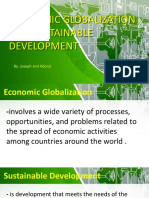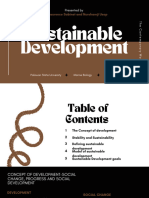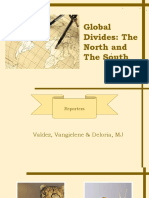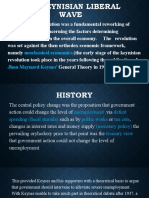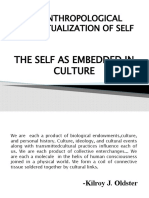0 ratings0% found this document useful (0 votes)
235 viewsGlobal Divides: The North and The South
Global Divides: The North and The South
Uploaded by
Marjorie O. MalinaoThe document discusses the concepts of the Global North and South. It describes how during the Cold War, countries were divided into the First, Second, and Third Worlds based on their economic status and political alignment. Now, the terms Global North and South are used instead, with the North generally referring to developed, industrialized countries and the South referring to developing, non-industrialized countries. The North and South are shaped by differences in definitions of poverty, wealth, development, and globalization. Regionalization divides areas into smaller segments while globalization promotes more integration across borders.
Copyright:
© All Rights Reserved
Available Formats
Download as PPT, PDF, TXT or read online from Scribd
Global Divides: The North and The South
Global Divides: The North and The South
Uploaded by
Marjorie O. Malinao0 ratings0% found this document useful (0 votes)
235 views9 pagesThe document discusses the concepts of the Global North and South. It describes how during the Cold War, countries were divided into the First, Second, and Third Worlds based on their economic status and political alignment. Now, the terms Global North and South are used instead, with the North generally referring to developed, industrialized countries and the South referring to developing, non-industrialized countries. The North and South are shaped by differences in definitions of poverty, wealth, development, and globalization. Regionalization divides areas into smaller segments while globalization promotes more integration across borders.
Original Title
Conword-Midterm-Lesson-1-North-and-South
Copyright
© © All Rights Reserved
Available Formats
PPT, PDF, TXT or read online from Scribd
Share this document
Did you find this document useful?
Is this content inappropriate?
The document discusses the concepts of the Global North and South. It describes how during the Cold War, countries were divided into the First, Second, and Third Worlds based on their economic status and political alignment. Now, the terms Global North and South are used instead, with the North generally referring to developed, industrialized countries and the South referring to developing, non-industrialized countries. The North and South are shaped by differences in definitions of poverty, wealth, development, and globalization. Regionalization divides areas into smaller segments while globalization promotes more integration across borders.
Copyright:
© All Rights Reserved
Available Formats
Download as PPT, PDF, TXT or read online from Scribd
Download as ppt, pdf, or txt
0 ratings0% found this document useful (0 votes)
235 views9 pagesGlobal Divides: The North and The South
Global Divides: The North and The South
Uploaded by
Marjorie O. MalinaoThe document discusses the concepts of the Global North and South. It describes how during the Cold War, countries were divided into the First, Second, and Third Worlds based on their economic status and political alignment. Now, the terms Global North and South are used instead, with the North generally referring to developed, industrialized countries and the South referring to developing, non-industrialized countries. The North and South are shaped by differences in definitions of poverty, wealth, development, and globalization. Regionalization divides areas into smaller segments while globalization promotes more integration across borders.
Copyright:
© All Rights Reserved
Available Formats
Download as PPT, PDF, TXT or read online from Scribd
Download as ppt, pdf, or txt
You are on page 1of 9
Global Divides:
The North and The South
What do you think?
Western Policy Makers – date back of Cold War. They talked about
the world has three(3) distinct Political and Economic Blocs.
FIRST WORLD – WESTERN CAPITALIST (U.S, U.K)
SECOND WORLD – SOVIET UNION (socialist) (Eastern European)
THIRD WORLD - NON-ALLIANCE COUNTRIES (Asia, Africa, Latin America)
After Cold War, First and Third World remains in the public consciousness.
Currently, many countries labeled as part of the First and Second Worlds during the
Cold War are now part of the Global North, while most of the Third World still belongs
to Global South.
First World – generally understood as referring to the developed countries.
(industrialized)
Third World – the underdeveloped and developing countries (non-industrialized or
semi-industrialized.)
They brought by differences in definitions of poverty, wealth and development.
GLOBAL NORTH AND SOUTH
NORTH
The terms Global North and South are way for countries in the south to make a
stand about the common issues, problems, and even causes to have equality all
throughout the world.
The difference between the Global North and Global South are shaped by
migration and globalization.
Nevertheless, the economic differences between the wealthy Global North and
poor Global South have always possessed a racial character.
The term also used to refer to the two halves of the current global system.
GLOBAL NORTH
Countriessuch as United States, Canada, Europe, Japan,
Singapore, South Korea, Australia, and New Zealand.
It refers to the rich and developed parts of the world.
Most of the countries have GDP per capita that is above the
world’s GDP per capita.
Politically, they are more powerful as an entity.
Monopolizes technological advances.
GLOBAL SOUTH
Countries such as Africa, Latin America, Developing
countries of Asia (Southwest Asia or Middle East).
It refers to the poor and developing half of it.
Mostof the nations have a GDP per capita below the world’s
GDP per capita.
Condemned to economic dependency.
REGIONALIZATION
Process of closer economic integration of countries within a region
(often times, culturally and geographically linked countries
The process of dividing an area into smaller segments called regions.
Businesses also use regionalization as a management tool and a way to
make certain that needs unique to particular areas are met.
One of the more obvious examples of regionalization is the division of
a nation into states or provinces.
Regionalization vs Globalization
The processes of globalization and regionalization reemerged during the 1980s
and heightened after the end of the Cold War in the 1990s.
The two are contradicting the very nature of globalization is by definition, global
while regionalization is naturally regional.
Globalization promotes the integration of economies across state borders all
around the world while Regionalization is precisely the opposite because it is
dividing an area into smaller segments.
Globalization allows many company to trade on international level so it allows
free market while in Regionalization, monopolies are more likely to develop
Regionalization vs Globalization
Globalization acceleration to multiculturalism by free and inexpensive movement
of people while regionalization does not support this.
Globalized international community is also more willing to come to the aid of a
country stricken by a natural disaster while regionalized system not get involved
in the affairs of others area.
Globalization has driven great advances in technology while in regionalization
advanced in technology is rarely available in one country or region only.
You might also like
- MR - Jack CrochetDocument7 pagesMR - Jack Crochetalejandra gonzalez100% (1)
- TCW Asian RegionalismDocument28 pagesTCW Asian RegionalismAgnesMagadia67% (6)
- An International Civilization, Empire, Internationalism and The Crisis of The Mid-Twentieth CenturyDocument9 pagesAn International Civilization, Empire, Internationalism and The Crisis of The Mid-Twentieth CenturyJoshua MurilloNo ratings yet
- Economic Globalization and Sustainability DevelopmentDocument56 pagesEconomic Globalization and Sustainability DevelopmentAdonis ClementeNo ratings yet
- Globalization: Debunking Convenient MythsDocument2 pagesGlobalization: Debunking Convenient MythsjamesbilesNo ratings yet
- Prepared By: Izabelle Joy A. Algar, LPTDocument21 pagesPrepared By: Izabelle Joy A. Algar, LPTArianne Rose FangonNo ratings yet
- Reviewer in Contemporary World: Global Divides: The North and The SouthDocument6 pagesReviewer in Contemporary World: Global Divides: The North and The Southjcb buraga100% (1)
- LM Global Divides The North and The SouthDocument42 pagesLM Global Divides The North and The SouthLyrics OnNo ratings yet
- GRP 1 Global DividesDocument32 pagesGRP 1 Global DividesCarla Marie De Guzman100% (1)
- Global Media CulturesDocument57 pagesGlobal Media CulturesSOBERANO, Noel Christian L.100% (1)
- Module 12 Global MigrationDocument13 pagesModule 12 Global MigrationGwyneth ValdezNo ratings yet
- Topic 6 Stances On Economic Global IntegrationDocument43 pagesTopic 6 Stances On Economic Global IntegrationLady Edzelle Aliado100% (1)
- Concepts of GlobalizationDocument24 pagesConcepts of GlobalizationBUBOY100% (1)
- Chapter 3-The Global Divides and Asian RegionalismDocument22 pagesChapter 3-The Global Divides and Asian RegionalismNicole Genzeinne Gumarao100% (1)
- 3 Ged 104 The Bretton Woods SystemDocument21 pages3 Ged 104 The Bretton Woods Systemjustine reine cornico100% (1)
- Chapter 2 - The Structures of GlobalizationDocument8 pagesChapter 2 - The Structures of GlobalizationElia NaNo ratings yet
- Lesson 3 - History of Global Politics Creating International OrderDocument31 pagesLesson 3 - History of Global Politics Creating International OrderBench AvilaNo ratings yet
- GE3 Defining Globalization and MetaphorsDocument20 pagesGE3 Defining Globalization and MetaphorshannahNo ratings yet
- Introduction To The Study of GlobalizationDocument19 pagesIntroduction To The Study of GlobalizationCheddy C. VillenaNo ratings yet
- Contemporary ReportDocument75 pagesContemporary Reportmry mnrnNo ratings yet
- GlobalizationDocument111 pagesGlobalizationJeanne100% (2)
- Global MigrationDocument25 pagesGlobal MigrationANGELIE CABADSANNo ratings yet
- Sustainable Development Powerpoint in The Contemporary WorldDocument28 pagesSustainable Development Powerpoint in The Contemporary WorldPilsam, Jr. SoteloNo ratings yet
- The Global Interstate SystemDocument34 pagesThe Global Interstate SystemRamil Billones100% (1)
- The Theories of Global StratificationDocument9 pagesThe Theories of Global StratificationRental SystemNo ratings yet
- Engage: Chapter Iv: The Global Interstate SystemDocument29 pagesEngage: Chapter Iv: The Global Interstate SystemJoey Aguilar VelascoNo ratings yet
- Global Demography G 1Document27 pagesGlobal Demography G 1Jemuel Luc JavierNo ratings yet
- Global DividesDocument13 pagesGlobal DividesRomelyn Duque DellomesNo ratings yet
- Chapter 3 - A World of RegionsDocument5 pagesChapter 3 - A World of RegionsJoanah Tayamen100% (2)
- Day 5 - Global Divide - Ms. Bualat PDFDocument35 pagesDay 5 - Global Divide - Ms. Bualat PDFNiccolo G. ChiongbianNo ratings yet
- Asian Regionalism and World of Ideas - TCWDocument30 pagesAsian Regionalism and World of Ideas - TCWJason Delos SantosNo ratings yet
- The Contemporary Global Governance PPT 4Document10 pagesThe Contemporary Global Governance PPT 4Cyanide048100% (1)
- Asian RegionalismDocument73 pagesAsian RegionalismAngeloNo ratings yet
- Lesson 6 - Global Divides The North-SouthDocument25 pagesLesson 6 - Global Divides The North-SouthNestor CabacunganNo ratings yet
- Global North and Global SouthDocument16 pagesGlobal North and Global SouthHenil SavaliyaNo ratings yet
- A World of RegionsDocument21 pagesA World of RegionsEliakim B. Ingente100% (1)
- Asian Regionalism 1Document10 pagesAsian Regionalism 1Emma Lyn EstrellaNo ratings yet
- Lesson 10 - Sex and GenderDocument41 pagesLesson 10 - Sex and GenderSilvia IonascoNo ratings yet
- Module 12 Global DividesDocument26 pagesModule 12 Global DividesRylee DungcaNo ratings yet
- Critical Examination of Media Role in GlobalizationDocument12 pagesCritical Examination of Media Role in GlobalizationDan Stanley100% (1)
- The Global DividesDocument32 pagesThe Global DividesAlex Remoquillo100% (1)
- Group 2 History of Global Market IntegrationDocument1 pageGroup 2 History of Global Market Integrationstephanie canapitNo ratings yet
- 6 Global Divides North and SouthDocument76 pages6 Global Divides North and SouthRaulyn Medina100% (1)
- The Global MigrationDocument29 pagesThe Global MigrationMarc Loui RiveroNo ratings yet
- Chapter 5 Asian RegionalismDocument15 pagesChapter 5 Asian RegionalismJorenn Gonzales SaligananNo ratings yet
- Lesson 7 Asian RegionalismDocument15 pagesLesson 7 Asian RegionalismNestor CabacunganNo ratings yet
- 7 CH Global Insterstate SystemDocument4 pages7 CH Global Insterstate SystemAndrea SiladanNo ratings yet
- Unit Ii Lesson3 - 4 - The Global Interstate SystemDocument15 pagesUnit Ii Lesson3 - 4 - The Global Interstate SystemIvy Lorenze Calingasan CortezNo ratings yet
- Ppt. Group 1 - The Practice of GlobalizationDocument8 pagesPpt. Group 1 - The Practice of GlobalizationCyrss BaldemosNo ratings yet
- GEC 3-Chapter 4 (Word)Document9 pagesGEC 3-Chapter 4 (Word)Felicity Jane BarcebalNo ratings yet
- Lesson 10 Global MigrationDocument14 pagesLesson 10 Global MigrationRodken VallenteNo ratings yet
- Media and GlobalizationDocument68 pagesMedia and Globalizationeerhan.v2No ratings yet
- WEEK 1 and 2Document31 pagesWEEK 1 and 2Hanareva ArvesuNo ratings yet
- Thecontemporaryworldlessons34 ANSWERSDocument3 pagesThecontemporaryworldlessons34 ANSWERSHannah Beatrice SalesNo ratings yet
- Global DividesDocument11 pagesGlobal DividesMikael Dominik Abad100% (2)
- Global Divides: The North and The SouthDocument17 pagesGlobal Divides: The North and The SouthLiezl Coronado villa50% (2)
- The World Is Now More Interconnected Than Ever BeforeDocument33 pagesThe World Is Now More Interconnected Than Ever BeforeEloisa YepezNo ratings yet
- Lecture 1 Introduction To The Study of GlobalizationDocument37 pagesLecture 1 Introduction To The Study of GlobalizationJarvie JohnNo ratings yet
- The Dynamic of Local and Global CultureDocument38 pagesThe Dynamic of Local and Global CultureAlondra L. FormenteraNo ratings yet
- Wallerstein's World System TheoryDocument28 pagesWallerstein's World System TheoryEmma Trev Noble100% (2)
- Unit 3 - A World of Regions Lesson 3.1 - Global DividesDocument7 pagesUnit 3 - A World of Regions Lesson 3.1 - Global DividesLevin HawthornNo ratings yet
- The Keynisian Revolution Was A Fundamental Reworking Of: Neoclassical Economics. Jhon Maynard Keynes'Document6 pagesThe Keynisian Revolution Was A Fundamental Reworking Of: Neoclassical Economics. Jhon Maynard Keynes'Marjorie O. MalinaoNo ratings yet
- Group 2Document19 pagesGroup 2Marjorie O. MalinaoNo ratings yet
- Topic I Global Population and MobilityDocument31 pagesTopic I Global Population and MobilityMarjorie O. Malinao100% (2)
- Kulet Contemporary World ReportDocument9 pagesKulet Contemporary World ReportMarjorie O. MalinaoNo ratings yet
- Understanding The Dynamics of CommunicationDocument19 pagesUnderstanding The Dynamics of CommunicationMarjorie O. MalinaoNo ratings yet
- Durante 1Document7 pagesDurante 1Marjorie O. MalinaoNo ratings yet
- The Keynisian Revolution Was A Fundamental Reworking Of: Neoclassical Economics. Jhon Maynard Keynes'Document6 pagesThe Keynisian Revolution Was A Fundamental Reworking Of: Neoclassical Economics. Jhon Maynard Keynes'Marjorie O. MalinaoNo ratings yet
- Types of Communication StrategiesDocument8 pagesTypes of Communication StrategiesMarjorie O. MalinaoNo ratings yet
- An Anthropological Conceptualization of Self: The Self As Embedded in CultureDocument8 pagesAn Anthropological Conceptualization of Self: The Self As Embedded in CultureMarjorie O. Malinao100% (1)
- Understanding The Dynamic of CommunicationDocument21 pagesUnderstanding The Dynamic of CommunicationMarjorie O. MalinaoNo ratings yet
- Advantages of Risk ManagementDocument2 pagesAdvantages of Risk ManagementMarjorie O. MalinaoNo ratings yet
- Group 2: Asian RegionalismDocument7 pagesGroup 2: Asian RegionalismMarjorie O. MalinaoNo ratings yet
- English For Academic and Professional Purposes: (Engprof)Document48 pagesEnglish For Academic and Professional Purposes: (Engprof)Marjorie O. MalinaoNo ratings yet
- Business-To-Business Marketing, Organizational Buying Behaviour, Interfirm Relationships and Network BehaviourDocument20 pagesBusiness-To-Business Marketing, Organizational Buying Behaviour, Interfirm Relationships and Network BehaviourMarjorie O. MalinaoNo ratings yet
- The Self From Various Philosophical PerspectiveDocument2 pagesThe Self From Various Philosophical PerspectiveMarjorie O. MalinaoNo ratings yet
- Types of Speech Acts: Click To Edit Master Title StyleDocument6 pagesTypes of Speech Acts: Click To Edit Master Title StyleMarjorie O. Malinao100% (2)
- Fundamental Movement in P.EDocument2 pagesFundamental Movement in P.EMarjorie O. Malinao100% (3)
- Analysis Report in Business MarketingDocument6 pagesAnalysis Report in Business MarketingMarjorie O. MalinaoNo ratings yet
- My Report in Macro PerspectiveDocument9 pagesMy Report in Macro PerspectiveMarjorie O. MalinaoNo ratings yet
- History of Hospitality Industry During Early Modern Period SoftDocument3 pagesHistory of Hospitality Industry During Early Modern Period SoftMarjorie O. MalinaoNo ratings yet
- Elements of PoetryDocument13 pagesElements of PoetryMarjorie O. MalinaoNo ratings yet
- Final Presentation Con WorldDocument13 pagesFinal Presentation Con WorldMarjorie O. MalinaoNo ratings yet
- How To Make A Simple and Parallel CircuitDocument1 pageHow To Make A Simple and Parallel CircuitMarjorie O. MalinaoNo ratings yet
- Drilling Equipment and Hand Tools (Revised)Document72 pagesDrilling Equipment and Hand Tools (Revised)Wai HtutNo ratings yet
- Director's CertificateDocument2 pagesDirector's CertificateNarciso Reyes Jr.No ratings yet
- Assignment - Week 10Document6 pagesAssignment - Week 10Nabella Roma DesiNo ratings yet
- Mic 1Document3 pagesMic 1Raul Augustus D. FACONNo ratings yet
- Economics Lesson Note For Grade 11Document10 pagesEconomics Lesson Note For Grade 11asedan40No ratings yet
- The Stag Hunt and The Evolution of Social StructurDocument7 pagesThe Stag Hunt and The Evolution of Social StructurMary Katherine NavarroNo ratings yet
- Employment News This Week 21st To 27th Jan 2023Document5 pagesEmployment News This Week 21st To 27th Jan 2023Rupam BurmanNo ratings yet
- Minar Plastic 0105 - 240329 - 151311Document3 pagesMinar Plastic 0105 - 240329 - 151311minarplastic200No ratings yet
- Material Schedule For Placenta Pit and Ash PitDocument63 pagesMaterial Schedule For Placenta Pit and Ash Pitjonathan chandaNo ratings yet
- Sodium Percarbonate-Oxygen Bleach TDSDocument2 pagesSodium Percarbonate-Oxygen Bleach TDSajeetranadaksh11No ratings yet
- KUT 4ADORAH005E - PT. Adovelin RaharjaDocument1 pageKUT 4ADORAH005E - PT. Adovelin Raharjajeri adovelinNo ratings yet
- RV Math AA HL - ProbabilityDocument4 pagesRV Math AA HL - ProbabilityMina FawzyNo ratings yet
- PB Canang Mechine SpecsDocument1 pagePB Canang Mechine SpecsRely TokNo ratings yet
- Beyond Income Redrawing Asias Consumer Map Discussion PaperDocument88 pagesBeyond Income Redrawing Asias Consumer Map Discussion PaperPiyawatr ZenNo ratings yet
- Ef3b HDT Bop PCB11Document42 pagesEf3b HDT Bop PCB11softfedblogNo ratings yet
- Handout 5: Production Functions and Cost MinimizationDocument10 pagesHandout 5: Production Functions and Cost MinimizationRaulNo ratings yet
- Marketing Plan EKODocument17 pagesMarketing Plan EKOEmir GlogićNo ratings yet
- Group 1 Math 01 Midterm PTDocument4 pagesGroup 1 Math 01 Midterm PThellotxt304No ratings yet
- Cost Chapter Notes Class 11 MicroeconomicsDocument9 pagesCost Chapter Notes Class 11 MicroeconomicsHarsha AmlaniNo ratings yet
- Caterpillar Vs Komatsu: Submitted ByDocument19 pagesCaterpillar Vs Komatsu: Submitted ByJayant Jaisingh Desai100% (1)
- Smart Trade Abg Din by Ahmadulhadi VER 2Document124 pagesSmart Trade Abg Din by Ahmadulhadi VER 2Joewayder Upat100% (3)
- A Learning Curve Describe1Document17 pagesA Learning Curve Describe1Hasnat AsifNo ratings yet
- Digital Wealth Creation SummitDocument2 pagesDigital Wealth Creation Summit6ystdimensionNo ratings yet
- Destini Oil Services SDN BHD.: Purchase OrderDocument2 pagesDestini Oil Services SDN BHD.: Purchase OrderSangu NagarjunNo ratings yet
- Gantt ChartDocument1 pageGantt ChartGILBERT SUMBILONNo ratings yet
- JOD13969Document2 pagesJOD13969Abhishek SinghviNo ratings yet
- Foundations of Modern Macroeconomics Third Edition: Chapter 1: Review of The AD-AS ModelDocument45 pagesFoundations of Modern Macroeconomics Third Edition: Chapter 1: Review of The AD-AS ModelAayush PandeyNo ratings yet
- IncubationDocument9 pagesIncubationoluchukwu u.No ratings yet
- 27PercentWeekly ReportDocument18 pages27PercentWeekly ReportVa AniNo ratings yet



